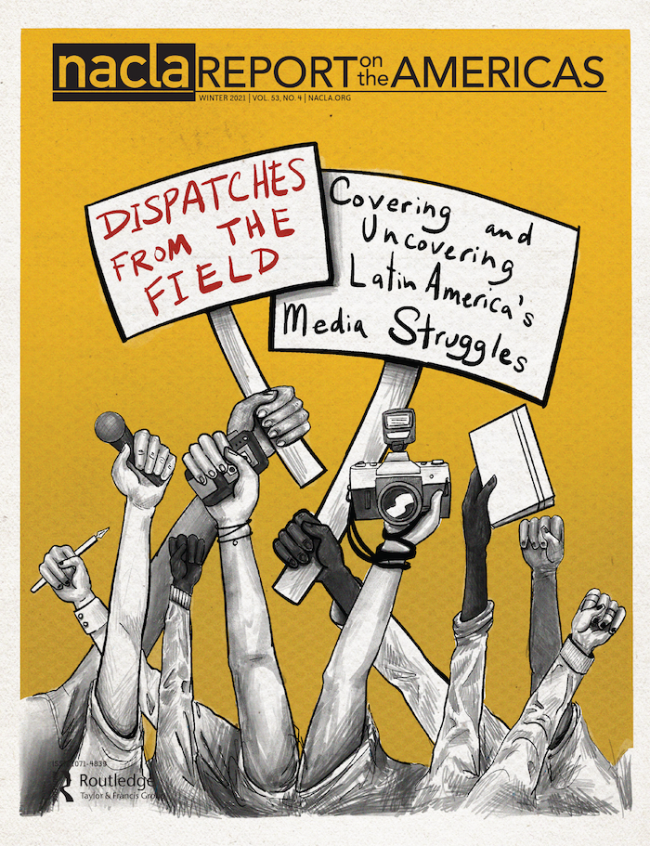
This piece appeared in the Winter 2021 issue of NACLA's quarterly print magazine, the NACLA Report. Subscribe in print today!
In the January 1969 issue of the NACLA Newsletter, founding Naclista Jon Frappier traced the webs of U.S. media empire in Latin America. Facing saturation in the domestic market, U.S. media corporations began expanding in the 1960s into Latin America’s growing television sector. Their investments promised to further concentrate ownership of the mass media and the viewpoints they represented, both in the United States and abroad.
Although the impact of this trend remained unclear at the time, Frappier predicted an undesirable outcome. “Television’s emphasis on consumerism will not only lead to increased frustrations for many Latin Americans, but it will continue to distort, as U.S. corporations have done in the past, the development of those societies,” he wrote. “The values projected by television programs and advertising imported from the United States will definitely affect the cultural integrity of the Latin American people.”
The media has obviously changed dramatically in the last five years let alone 50. Yet Frappier’s words help us appreciate how a shift away from a linear understanding of mass communications also comes to bear in how we think about the relationship between the United States and Latin America and our respective information systems. This NACLA Report reflects on the current state of the media landscape in Latin America and particularly how journalism takes shape within and responds to these evolving conditions. The issue centers the work of reporters and researchers in the region who face firsthand the urgent challenges and uncertainties defining media today.
In the last two decades, NACLA has published two Reports focused on the media. The January/February 2004 issue “Media in the Americas,” excerpted here in our From the Archives section, came at the height of the Indymedia movement. While consolidation of commercial media in the region continued at a dizzying rate, the early 2000s also marked a dynamic time of emergent alternatives. Then, the Fall 2012 issue “Radical Media” asked: who gets to tell the story and how? The issue came on the heels of popular struggles—like the Arab Spring, Occupy Wall Street, Spain’s Indignadxs, and Mexico’s #YoSoy132 student movement—that harnessed social media in innovative ways. The authors focused on grassroots communications initiatives as tools of protest and civic engagement.
Since then, alternative media outlets in the region have further professionalized, and many have undertaken hard-hitting investigative reporting. With political polarization and distrust in traditional media running high, numerous fact-checking projects—such as the trailblazing Chequeado in Argentina, as well as ColombiaCheck, El Sabueso in Mexico, Agência Lupa and Aos Fatos in Brazil, and others—have emerged to debunk and combat misinformation. Latin American journalists have collaborated in major global reporting partnerships like the Panama and Pandora Papers, podcasts have taken off, and outlets have experimented with new audience engagement strategies, such as sharing content through WhatsApp. A small but growing number of Latin American independent media now make their work available in English. And journalists in the region and beyond have increasingly drawn attention to harmful and imperial practices in foreign correspondence. Though it has yet to prompt a reckoning, this conversation—nudged forward in spaces such as Columbia Journalism Review—is crucial.
These shifts and innovations come against the backdrop of a changing political landscape. As Gustavo Fuchs discusses with four scholars of media ownership in this issue, the rise and fall of the Pink Tide brought processes of reform and counter-reform, including in national communications industries. Ultimately, even though a new generation of digital outlets have entered the scene, the big conglomerates have remained intact. In Argentina, for instance, Grupo Clarín dominates, and in Brazil, Grupo Globo is the biggest player in a market that Reporters Without Borders gives a “red alert” score for media concentration.
Despite this difficult context, independent media projects have succeeded in bringing new perspectives and topics into view through various storytelling formats. Several pieces in this issue highlight the journalistic work of these alternatives, how they reimagine the role of media, and the struggles they face.
Read the rest of this article here, available open access for a limited time.
Heather Gies is managing editor of the NACLA Report.
Cover art by Hugo Gonzalez

